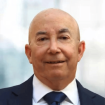Key Takeaways
- Congress out for Memorial Day break.
- Powell to White House for Tuesday meeting.
- Fed FOMC meeting approaches June 14-15, 50bps hike seems most likely.
- Will new Governors have any impact?
- Biden meets with leaders of Japan, India and Australia to explore trade partnership.
- Did Georgia primary impact Trump’s role in Republican Party?
Fed
The White House has announced that President Biden will meet today with Fed Chair Jay Powell. It is not that unusual for the President and Fed Chair to talk, and Biden has made clear he will not try to jawbone Powell on policy. The Fed Chair and Treasury Secretary meet regularly, and this has been true for Powell and Yellen.
I worked with Jay Powell when he served in Bush 41 Treasury and he was widely viewed as a strong policy person with experience on Wall Street. It is this solid respect that had him nominated by both Trump and Biden, and awarded him the praise he won during the pandemic.
The White House meeting occurs as the Fed’s Federal Open Markets Committee (FOMC) prepares to meet again on June 14-15.
A month ago, there was talk as to whether the FOMC would put its foot on the rate accelerator and move rates up 75bps, but at the press briefing after the May meeting Chair Powell put an end to that conversation, and now the expectation is for another 50bps increase. With signs of a slowing economy the talk is now focused on how long the 50bps policy will continue.
A factor that has been largely overlooked is that the Senate has now confirmed two Biden Fed Governors who will sit in their first meeting in June. Additionally, Obama nominee Dr. Lael Brainard now sits as the Vice Chair of the Board, and an additional Biden nominee, Michael Barr, awaits Senate action. The FOMC has the seven Board Governors and additionally five regional bank Presidents, all of whom vote on rate policy. As Chair Powell has been clear, he prefers telegraphing future policy rather than surprising markets; it will be interesting to see if any of the new Governors, or Vice Chair Brainard speak about rate policy in the next two weeks.
Asia
The centerpiece of President Biden’s recent visit to Japan was a mini regional summit where the President and Japanese Prime Minister were joined by the leaders of India and Australia. The Australians had just conducted an election and the new Prime Minister, Anthony Albanese, was quickly sworn in so that he could attend the meeting.
The leaders all agreed to try and re-establish a more formal trading partnership that slipped away when President Trump rejected the Trans Pacific Partnership (TPP) that had been negotiated during the Obama Administration. This is the beginning of the trade talks, and at this point it is hard to see what pace the negotiations will take.
As is too often his pattern, President Biden made a diplomatic gaffe when he bluntly answered a reporter’s question on US/Taiwan relationship stating that the US would fight to defend Taiwan if there was a Chinese invasion. Ever since US/China policy was reset by President Nixon there had been a policy of ambiguity on the status of Taiwan, and in this case Administration officials were quick to cleanup and clarify that our policy of vagueness had not changed. US/China relations remains one of the key global issues for the Administration, and China’s carefully crafted statement on the war in Ukraine has added a new level of tension to the relationship.
Midterms
Last week the primary season continued with Georgia’s primary elections. The results showed both the central role former President Trump plays in the party, and also a growing willingness by Republican voters to vote against the stated position of the former President.
The well-publicized rejection of Trump’s candidates by Georgia Republican voters in the victories for Governor Brian Kemp and Secretary of State Brad Raffensperger was significant. President Trump had personally recruited challengers to run against both office holders. Both candidates got more than the 50% of the vote to avoid a runoff, Kemp got a huge victory with 73% of the vote, while Raffensperger got 52% of the vote.
While the press focused on these two races, President Trump got his handpicked candidate for the US Senate, former football star Herschel Walker, across the goal line to challenge incumbent Senator Raphael Warnock. Walker wouldn’t have been a viable candidate without Trump’s support. He has never run for office and is prone to answers to press questions that can be baffling.
The victory by a football star follows a pattern in handpicked Trump candidates – celebrities like he was prior to his Presidential run. Examples of this strategy are JC Vance in Ohio, and the strong run by Dr. Oz in Pennsylvania. The press, I believe, is premature in highlighting the Trump supported candidates who lost. President Trump continues to be the center of gravity in the national Republican Party and he continues to play a significant role in the direction taken by Congressional Republicans.



